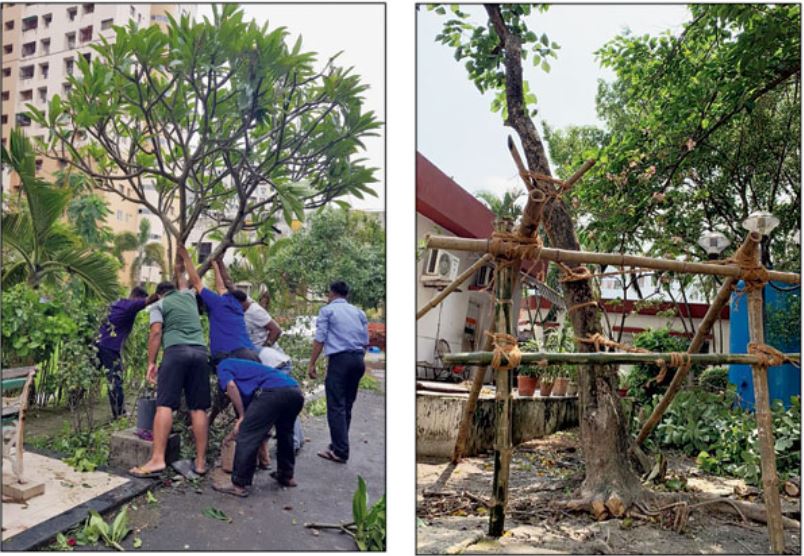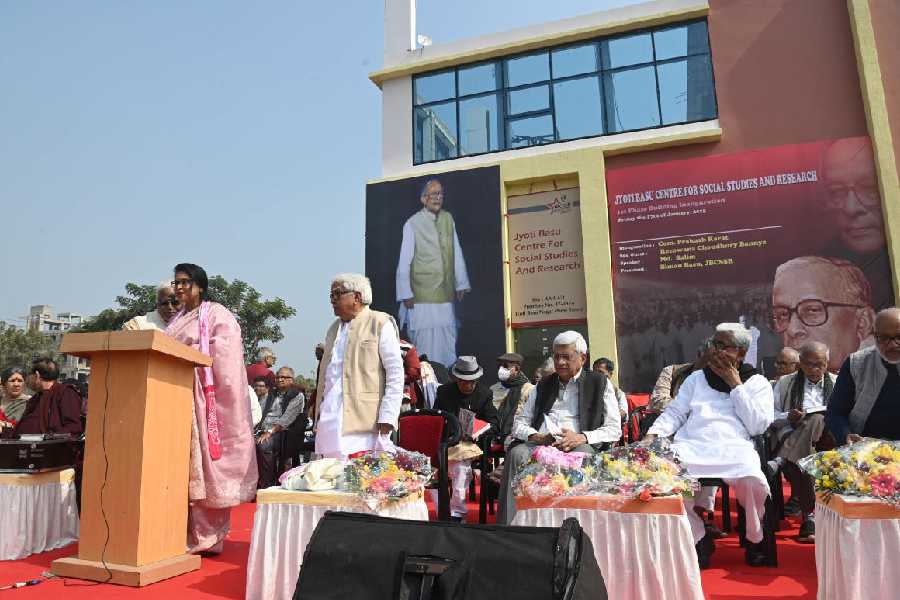While fallen trees dot each and every thoroughfare across Salt Lake, heavily depleting the township’s green cover, a ray of hope has emerged from neighbouring New Town where some fallen trees are being replanted.
The New Town Kolkata Development Authority (NKDA) estimates that about 3,000 trees have fallen, including small ones. “According to our tree census, New Town has about 38,000 trees. Our first priority was to clear the main roads for essential services like ambulances. For that we had to cut some trees. But for the rest, the instruction was to save as many as possible. It takes considerable manpower and effort to prop up a full-grown tree but still we are doing it. We have already been able to save 100 trees,” said NKDA chairman cum managing director Debashis Sen.
The species that have got most impacted by the cyclone Amphan are babla, krishnachura, radhachura and a few coconut trees. “New Town used to be barren. We have planted these trees ourselves. They are like our children,” he added.
Private initiatives are also being reported from across the township. At least five housing societies have taken an initiative to save the trees that had fallen on their premises.

Roots of a fallen tree being cleared of clay before being replanted at Rosedale Garden in New Town. It was one of about 60 trees that were saved in the housing complex. A Telegraph picture
The first complex to act was Rosedale Garden. “We have one of the finest central lawns among the housing complexes in New Town with close to 100 varieties of trees. We have nurtured these trees with a lot of care over 10 to 12 years. We will try to save each and every tree that has fallen,” Ranjan Basu of Rosedale Garden told The Telegraph Salt Lake on Friday, two days after the cyclone struck Bengal. As he spoke, people tied a nylon rope around the trunk of a prostrate ficus benjamina and hauled it up. “Chopping a fallen tree is easy. We are taking the bigger challenge,” he added. Close to 40 trees had got flattened by the cyclone in the complex.
As word spread about their attempt, other housing complexes also came forward. “We are really attached to our trees as we have seen them grow ever since we settled in the complex. Residents used to feed the birds nesting here. When the storm uprooted so many of them, children in many apartments were crying. We had no idea that the trees could be replanted. Once we heard about Rosedale’s initiative, we got in touch with the nursery that takes care of their greenery,” said Biplab Basu, secretary of Greenwood Park in Action Area 1. The three biggest trees could not be saved. But the other 20-odd could be. “The people from the nursery along with our men worked for six hours. We will keep the trees tied to a support for the next six-seven months till they firmly take root again.”
Next door to Greenwood Park, Utsa Luxury was also looking up ways to save about 20 trees that had suffered in the cyclone. “Where would we get manpower amid the lockdown? So over 15 residents joined hands with four security guards under the guidance of our gardener. Four trees which had got completely uprooted were beyond help. We used the Y-shaped branches of those trees to provide support to the ones that we could revive. The whole process took us three days,” said Kanu Bhowmick, secretary of Utsa Luxury Complex Apartment Owners’ Association. “The Krishnachura-Radhachura trees were about 15 years old. If we tried planting saplings in their place, it would take another 15 years to grow back to that height.”
Pallab Roy of Sunrise Symphony has been checking on the trees they tried to save every day. “We are taking turns to look up how the replanted trees are faring. Today the rope we had tied them with to the boundary wall seemed less taut, which would mean the tree is taking root. Twelve trees fell in our campus. Eight could be saved. On our gardener’s advice, a hole deeper by another foot was dug for the trunk to be fitted in,” said the treasurer of Sunrise Symphony Apartment Owners’ Association.
If these trees were all within the campus of the complexes, Akankha tried saving even trees on the divider outside. “About eight trees were standing but leaning at a steep incline. Though it was on the road divider, we, the three adjacent housing societies, had planted them at our own expense. Our gardeners tried to make them stand. When they failed on their own, the housekeeping boys joined them. They trimmed the branches and created a bamboo scaffold all around to provide them support,” said Dibyendu Roy, Akankha Krishnachura Apartment Owners Association. Half a dozen trees inside the campus were similarly restituted.
The knowhow for the resurrection of the trees at Greenwood Park and Rosedale was provided by Arjun Sarkar, the owner of Sarkar Nursery near Vedic Village. “Cyclone Aila did not create as much havoc 11 years ago as Amphan has simply because New Town did not have so many trees then,” he said. The first step to make a tree stand up again is to trim the extra branches and reduce the load on the main stem. The next step is to free the roots of clay. Some twisted roots might need to be chopped, ensuring least damage to the tree. Then once the tree is up, it would need support, be it on bamboo poles or simply of rope tied to something stable. Then fresh soil needs to be inserted in the hole. “Since this is high summer, I expect the roots to clutch the soil soon. The arrival of monsoon would be an added advantage. The process takes much longer in winter,” he explained.
At Rosedale, Sarkar says, his men managed to save about 60 trees. “There are several varieties of Ficus at Rosedale. Only 7-8 kadam trees could not be saved. We could save the remaining 70 or so trees. We added some rooting hormone to the soil. At Greenwood Park, it was mix of species - ficus, palash, kanchan, jarul…,” he added.
In New Town’s CE Block, a tree escaped the hatchet almost miraculously. “The NKDA men chopped the branches and had landed the first blow on the trunk when the tree that was bent double suddenly sprang to an erect position!” exclaimed Alok Das, secretary of CE Block Cultural Association. About 10 trees had been damaged in the cyclone. The rest were chopped. “We will plant saplings in their place if NKDA doesn’t. In any case, we plant 100 saplings every year,” he said.











